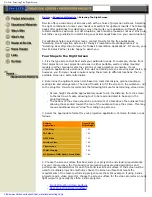
9. Image menu
Image 9-71
Image 9-72
Image 9-73
Image 9-74
9.5.3
Advanced settings,
fi
lm mode detection
About
fi
lm mode detection
This mode detects whether
fi
lm or video is displayed.
When enabled, the hardware looks for tell-tale signs of 3:2 or 2:2 pull-down sequences. These are the result of converting cinema
material recorded at 24 frames-per-second to the television frequencies of 60 or 50 interlaced
fi
elds per second respectively. When
FILM conversion is detected, the original 24 frames-per-second are restored. This avoids deinterlacing artefacts, and results in a
perfect artefact-free display. Note that in some cases (video clips, scrolling newstickers,...) FILM and VIDEO material are mixed
on one screen. This may confuse the detector and cause it to go into FILM restoration mode. This will cause "jaggies" or motion
artefacts. In such cases, disabling FILM mode processing is the best cure.
Film mode detection is only for interlaced sources.
3:2 pull-down
Method used to map the 24 fps of
fi
lm onto the 30 fps (60
fi
elds) or 25 fps (50
fi
elds), so that one
fi
lm frame occupies
three video
fi
elds, the next two, etc. It means the two
fi
elds of every other video frame come from different
fi
lm frames
making operations such as rotoscoping impossible, and requiring care in editing. Some sophisticated equipment can
unravel the 3:2 sequence to allow frame-by-frame treatment and subsequently re-compose 3:2. The 3:2 sequence
repeats every
fi
ve video frames and four
fi
lm frames, the latter identi
fi
ed as A-D. Only
fi
lm frame A is fully on a video
frame and so exists at one time code only, making it the editable point of the video sequence.
2:2 pull-down
The process of transferring 24-frames/sec
fi
lm format into video by repeating each frame (used for PAL DVD’s) as two
video
fi
elds. ( AD )
Artefacts
Undesirable elements or defects in a video picture. These may occur naturally in the video process and must be
eliminated in order to achieve a high-quality picture. Most common in analog are cross color and cross luminance.
Most common in digital are macroblocks, which resemble pixelation of the video image.
88
R59770021 CLM R10+ 15/03/2010
Содержание R9050100
Страница 1: ...CLM R10 Users manual R9050100 R90501001 R59770021 10 15 03 2010...
Страница 14: ...1 Safety 10 R59770021 CLM R10 15 03 2010...
Страница 22: ...2 General 18 R59770021 CLM R10 15 03 2010...
Страница 35: ...3 Physical installation Skew Image 3 28 Skew adjustment R59770021 CLM R10 15 03 2010 31...
Страница 36: ...3 Physical installation 32 R59770021 CLM R10 15 03 2010...
Страница 48: ...5 Connections 44 R59770021 CLM R10 15 03 2010...
Страница 64: ...7 Start up of the Adjustment mode 60 R59770021 CLM R10 15 03 2010...
Страница 74: ...8 Input menu 70 R59770021 CLM R10 15 03 2010...
Страница 115: ...10 Layout menu Image 10 61 Image 10 62 Image 10 63 Image 10 64 R59770021 CLM R10 15 03 2010 111...
Страница 116: ...10 Layout menu 112 R59770021 CLM R10 15 03 2010...
Страница 158: ...13 Projector control 154 R59770021 CLM R10 15 03 2010...
Страница 172: ...14 Service menu 168 R59770021 CLM R10 15 03 2010...
Страница 186: ...16 Servicing 182 R59770021 CLM R10 15 03 2010...
Страница 195: ...17 Projector covers removal and installation Image 17 18 Secure the lamp door R59770021 CLM R10 15 03 2010 191...
Страница 196: ...17 Projector covers removal and installation 192 R59770021 CLM R10 15 03 2010...
Страница 204: ...C DMX Chart 200 R59770021 CLM R10 15 03 2010...
Страница 210: ...D Specifications 206 R59770021 CLM R10 15 03 2010...
Страница 216: ...E Troubleshooting 212 R59770021 CLM R10 15 03 2010...
Страница 222: ...F Mounting optional Carry handle 218 R59770021 CLM R10 15 03 2010...
Страница 224: ...G Order info 220 R59770021 CLM R10 15 03 2010...
Страница 232: ...Index 228 R59770021 CLM R10 15 03 2010...
















































